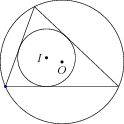Asymptote: Useful commands and their Output
For each of the following, we have put a blue dot at the origin in order to indicate relative location of the output on the coordinate plane. In other words, assume that before each of the examples below is the command
dot((0,0),blue);
In addition, a comment after a line such as //math indicates that the command used in that line is defined in the math package, thus motivating the include math; (or other appropriate package) line at the top of the example.
Example 1:
dot((20,0));
Example 2:
draw((0,0)--(50,0),BeginArrow); draw((0,-10)--(50,-10),MidArrow); draw((0,-30)--(50,-30),Arrows);
Example 3:
draw((0,0)--(50,0)); arrow((30,0),dir(180),green);
Example 4:
include math; pair A,B,C,D,E; A=(0,0); C=(50,0); B=(10,10); D=(40,20); E=extension(A,B,C,D); // extension is a command from the math package // that returns the intersection of lines AB and CD draw(A--B); draw(C--D); draw(B--E--D,orange);
Example 5:
include graph; draw(Circle((0,0),20));
Example 6:
path p=(0,0)..(20,15)..(40,-5)..(50,0); draw(p); draw(rotate(90)*p,green); draw(rotate(180,(-5,0))*p,orange); draw(shift((5,20))*p,magenta); draw(shift((0,-25))*yscale(1.4)*p,red);
Example 7:
include olympiad;
pair A,B,C,O,I;
A=origin; B=2*right; C=1.5*dir(70);
O=circumcenter(A,B,C); // circumcenter is a command in the Olympiad package
I=incenter(A,B,C); // incenter is a command in the Olympiad package
draw(A--B--C--cycle);
dot(O);
dot(I);
draw(circumcircle(A,B,C));
draw(incircle(A,B,C));
label(" ",I,W);
label("
",I,W);
label(" ",O,S);
",O,S);
Example 8:












